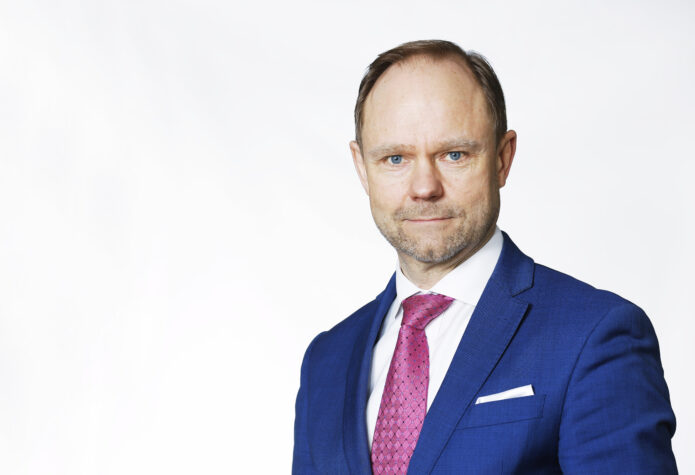Nordic-Baltic region, what’s next?

By André Küüsvek, President and CEO of the Nordic Investment Bank
Growing up in Tallinn in the 1970s, my connection to the Nordics reached as far as the Finnish broadcasting signal could get. It was hard to imagine sharing the lifestyles of those seen on Yle and MTV, let alone talking about a common Nordic-Baltic region.
However, we always felt a strong connection. Working in Germany in the mid-1990s, I recall my supervisor asking me whether Estonia was part of Central or Eastern Europe. My response was imminent: “No, we are part of Northern Europe”. Yet, that may not have been what the Nordics thought of Estonia at the time.
While regaining independence allowed us to voice these Nordic aspirations more loudly, it was not until the early 2000s that they truly kicked off.
In 2004, Estonia, Latvia, and Lithuania became part of the EU and NATO to consolidate their direction towards the West. What is less known, on 1 January 2005, the Baltic countries also joined the Nordic Investment Bank (NIB) on an equal footing with its original members – Denmark, Finland, Iceland, Norway, and Sweden.
Over the past two decades, the Baltics have transformed into modern democratic societies. During 2005-2024, their GDP per capita has tripled. Joining the western markets and communities also came with a surge in foreign direct investment, which has led to a notable increase of living standards.
All three countries have been steadily climbing in the rankings for competitiveness, ease of doing business, or economic freedom, competing for top spots with their Nordic companions.
The once distant vision of a Nordic-Baltic region has, indeed, become a reality. And as external forces are trying to reshape this new reality to their own, that region is coming closer together.
So where do we go next?
The NIB owners discussed the needs of their countries, and how the Bank can support them in Tallinn in March 2024. The message was clear: whilst the environment and productivity shall remain at the core of NIB’s mission, the Bank should also focus on cementing regional resilience and security.
For me, these priorities are mutually reinforcing. Let me illustrate this through the lenses of energy, innovation and long-term resilience.
Energising independence
From the very beginning, breaking the Baltic energy isolation has been among the main objectives for NIB. “Estlink” 1 and 2, “LitPol Link,” and “NordBalt” have interconnected the electricity markets. The final piece of the puzzle comes in February, when the plug on the Russian and Belarusian system (BRELL) will be pulled to join the Continental European grid.
Another milestone: on 6 December, Finnish Independence Day, Lithuania acquired its LNG carrier from a Norwegian company. For those into such symbolism, think how the natural gas imported through the terminal named “Independence” can be stored in the Inčukalns underground facility in Latvia and transported to Estonia and Finland via “Balticconnector”.
Looking ahead, NIB’s strategy in the Baltics will pivot more towards green transition. Here, Estonia, Latvia and Lithuania could still learn from the Nordics, which have demonstrated that economic development and sustainability can go together.
Enefit Green’s, Latvenergo’s and Ignitis’ investments in renewable capacities and transmission networks have already begun to accelerate this transition at a rapid pace. By transforming their power supply, the Baltics are shifting their past dependence on Russian imports to sustainable and autonomous energy for the future.
Unlocking private sector potential
Affordable energy is vital for technology-driven investments and industries. This is where NIB sees the next opportunity for the Baltic countries. This will be another area where NIB wants to increase its focus by extending financing to private enterprises.
The competitive advantages of this region lie in our people, our determination and our size. By building on our agility and flexibility, we can create innovative economies. The opening of Celltechna’s gene therapy centre in Vilnius is a good example of this, showcasing how private capital and governments’ strategic priorities can go hand in hand.
But to ensure we remain competitive, we have no time to waste. We need to leverage our innovation potential to stay at the forefront of new and emerging technologies. We need to remove the remaining bottlenecks to stimulate investments.
Creating long-term resilience
The investments of today will ensure sustainable growth tomorrow. But to truly talk about a resilient future, security is paramount.
Russia’s war in Ukraine and conflicts around the world have shifted government agendas. Alongside long-term climate and economic targets, geopolitical developments have highlighted the need to secure critical supply-chains, enhance data and information infrastructure, and build stronger defence capabilities.
As part of this shift, all eight NIB’s Nordic-Baltic member countries are now part of NATO.
In response to their most pressing needs, NIB has revised its policies. We have opened up to financing the defence sector and associated infrastructure, except for weapons and ammunition. This is a big step for a multilateral finance institution, speaking volumes of the changed security landscape. This year, we expect the first defence-related projects to materialise.
Stronger together
As we enter 2025, staying the course on the environment, productivity and regional security is more important than ever.
The good news is, unlike the 1970s, the Baltics have their destiny in their own hands; unlike in the 2000s, they no longer need to re-establish their seat in the international community.
Our closest partners are sitting at the same table. The Nordic-Baltic region is stronger together. Never alone again!
The column has been published in Estonian, Latvian and Lithuanian and can be found here: